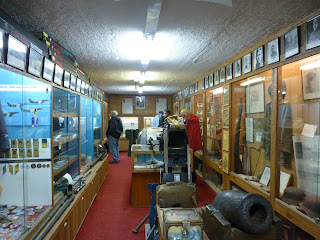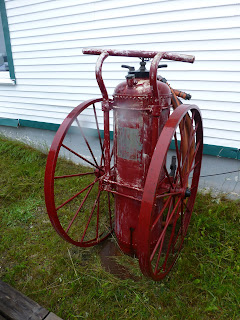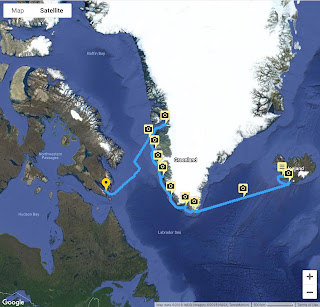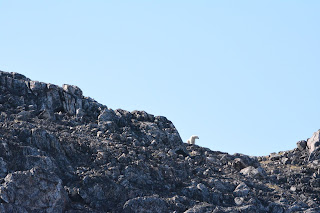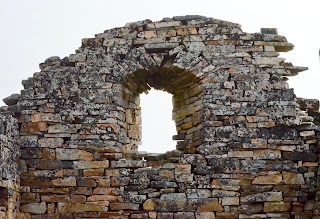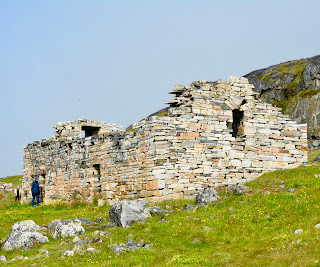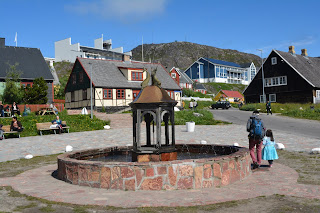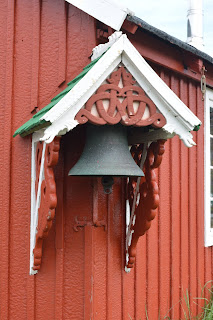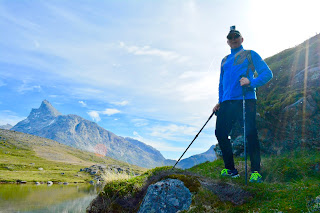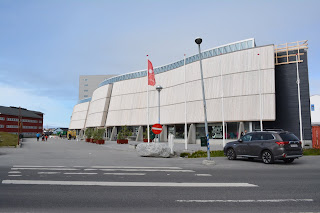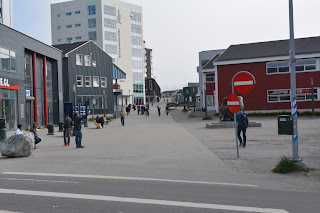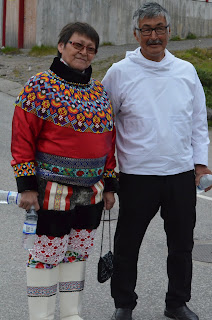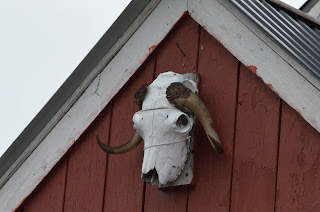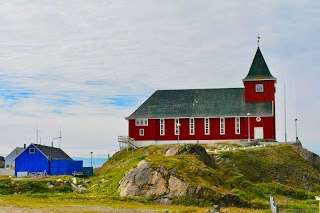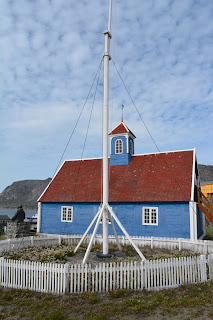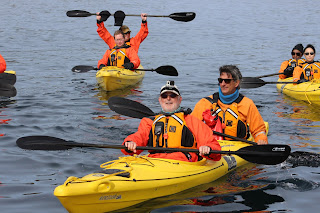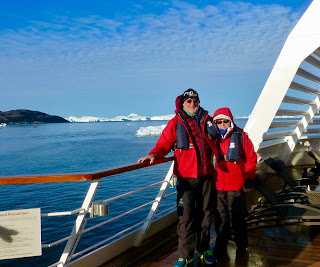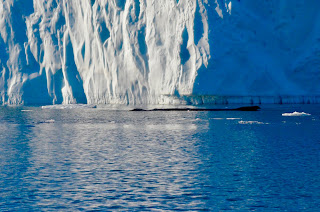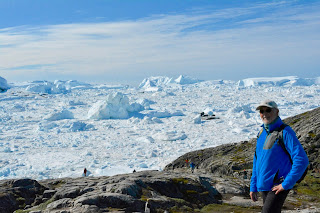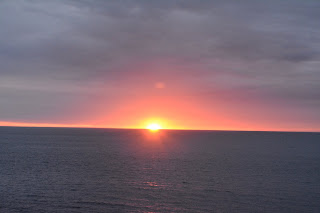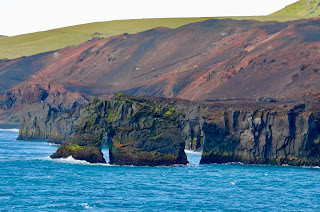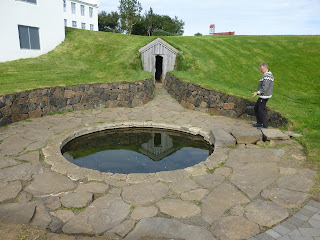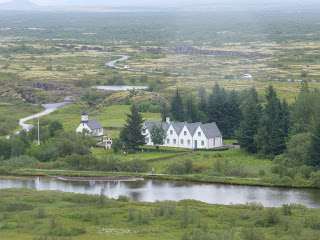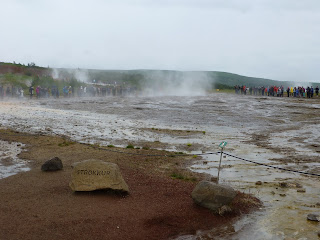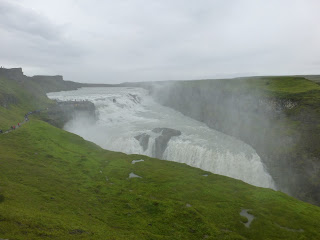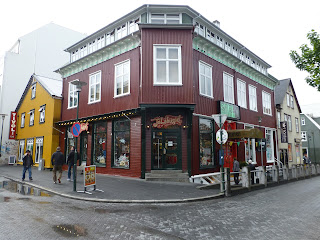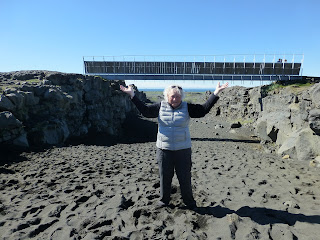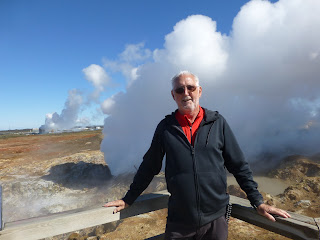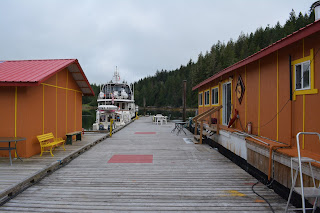Our 2018 summer was mostly unremarkable, the bulk of our time spent at our “home” base at Stansbury, tending to aging parents, enjoying crabs from Frank’s crab outings, lots of dog swimming, Mexican Train, and enjoyable times with good friends. We planned to depart Sept. 15, much earlier than our typical end of October departure, […]
Tag Archives | Selene
Route of the Vikings – Post 7
August 24, 2018
At Sea
Today we are headed to the final proven stop on the route of the Vikings. We are at sea all day as we pass down the Labrador coast, still seeing the occasional iceberg. The wind is 25-35 knots on our stern, but at least the temperatures are around 50 degrees.
August 25, 2018
L’Anse aux Meadows, Newfoundland, Canada
The Seabourn Quest pulled into a bay a few miles from the tender landing point and anchored shortly after 0700. By 0830 we were ashore and headed first to Norstead, a re-creation of a failed Viking settlement from the time of Leif Erickson, predating Columbus in North America by 500 years. The actual site was discovered in the 1960’s and the archeological evidence confirms the written sagas from the Viking era.
Norstead was built for the 2000 Millenial Celebration to avoid too much damage to the actual site from the tens of thousands who attended.
The actual site is now a Unesco World Heritage site and a Canadian National Park. At the site, the foundations of the sod houses are still visible, but have been recovered with sod to preserve them for future generations. Adjacent to the foundations is another recreation of what the site would have looked like 1000 years ago, complete with actors in period attire doing daily activities similar to what historians believe may have taken place.
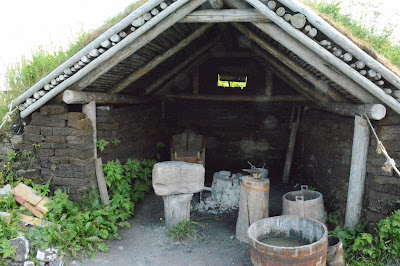 |
| Forge at L’Anse aux Meadows |
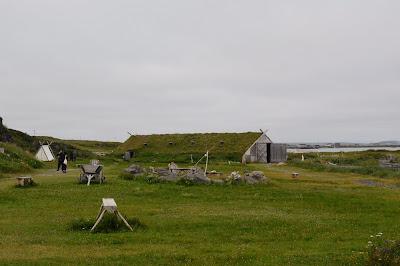 |
| Recreated settlement at Norstead |
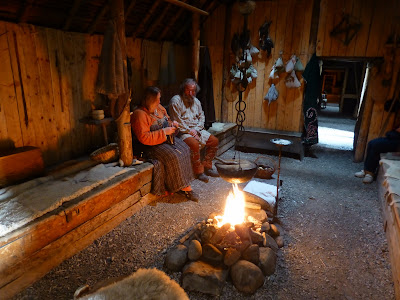 |
| Inside the sod houses |
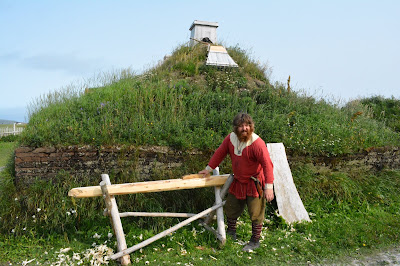 |
| Using Norse tools |
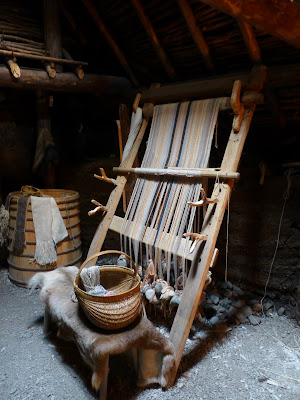 |
| Loom |
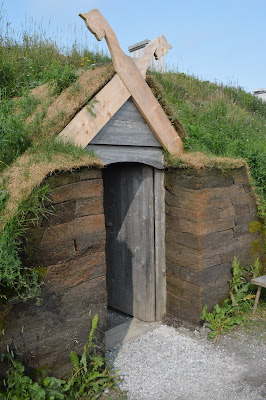 |
| Entrance into Sod Houses |
 |
| Primitive Lathe |
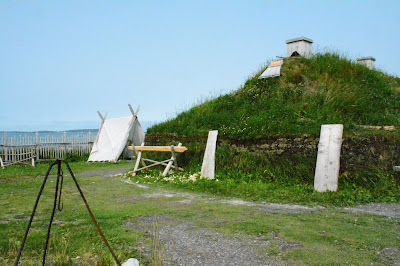 |
| Sod House |
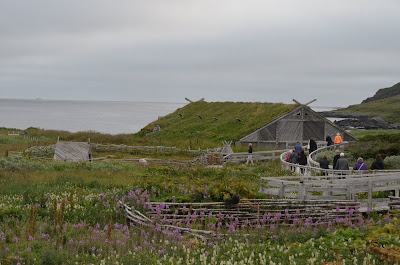 |
| Large Sod House, Contains Viking Longboat |
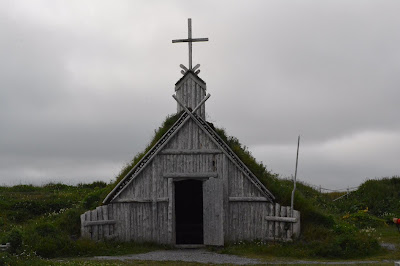 |
| Sod House Church |
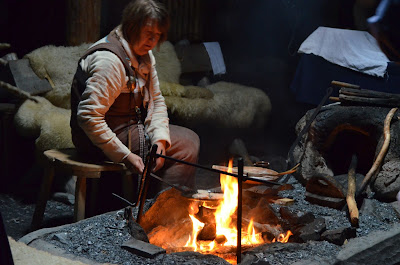 |
| Cooking Flatbread |
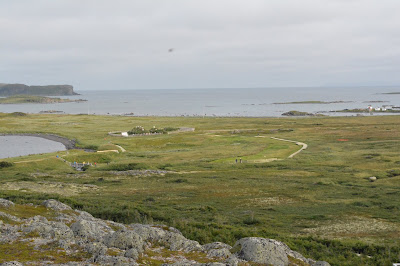 |
| Looking over Archeological Site |
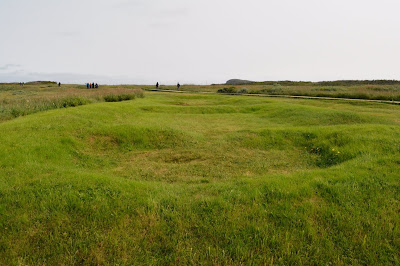 |
| Original Foundations recovered to protect the site |
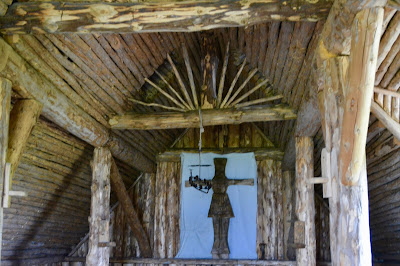 |
| Inside Chapel |
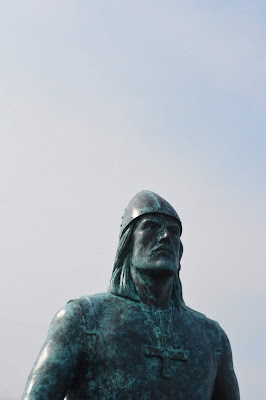 |
| Leif Erikson Memorial from Seattle |
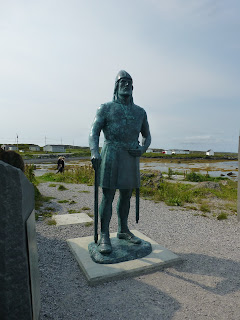 |
| The statue is near the tender landing |
 |
| Building are filled with items that would have been from 1000 years ago |
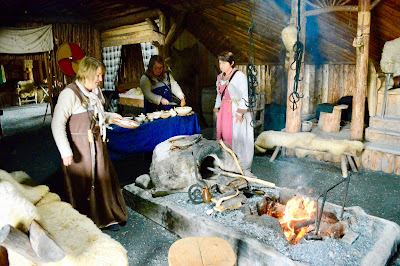 |
| What a cooking fire and oven may have looked like 1000 years ago |
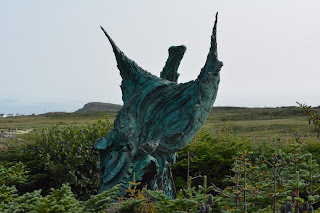 |
| Sculpture at L’Anse aux Meadows |
At the small boat landing there is a donated copy of the Leif Erickson stature from Seattle, donated by various Seattle civic groups in 2013.
The site at L’Anse aux Meadows marks the end of the verifiable trail of the Viking presence in North America and is believed to have been used only as a gateway for other explorations, for which no firm evidence has been found elsewhere. The expansion of easier trade routes in Europe is thought to be the reason the site was abandoned after only 50-70 years.
The archeological sites we saw in Greenland were abandoned in the 1400’s, probably due to the increasingly cold climate from the climate changes then occurring.
So ends the Route of the Vikings, but still more stops before we arrive in Montreal.
August 26, 2018
Red Bay, Labrador
After leaving L’Anse aux Meadows, the Seabourn Quest travelled only 45 nautical miles across Belle Isle Straits back into Labrador and anchored off the small town of Red Bay, only 230 residents. This town was once a thriving Basque fishing and whaling village, but that is long gone. There is no cell phone service and few other services.
At 0800 we departed on the tender and boarded a school bus for the lengthy trip west down the coast, passing several more small communities, over a combination of paved and gravel roads, both filled with potholes. The school bus seats are very close together and the bus had poor suspension. Nonetheless, after 75 minutes of bouncing, we arrived at one of the tallest lighthouses in Canada, the Point Amour light, which has been in continuous operation for 160 years. The light is 132 feet above ground and 180 feet above sea level, easily illuminating the 9 mile wide Belle Isle Strait.
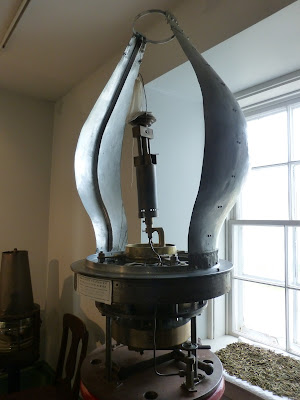 |
| Original Light |
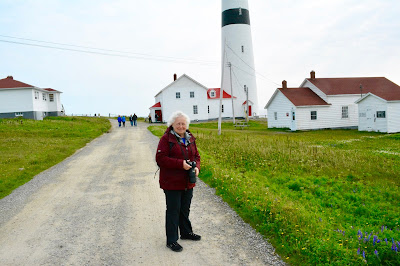 |
| Miriam at Point Amour |
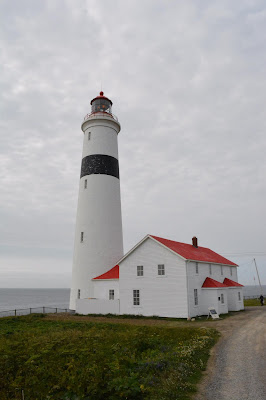 |
| Point Amour Lighthouse |
 |
| Wind Signal Flags |
The lighthouse is one of four “Imperial” lighthouses, so-called because England provided the funds for construction, that provide navigational aids to Belle Isle Strait. Belle Isle Strait is a shortcut between England and the Saint Lawrence, nearly 200 nautical miles shorter that the deeper water route via Cabot Straits on the south side of Nova Scotia.
We were able to climb the lighthouse and walk through many rooms of exhibits and enjoy some local desserts made from the Partridge Berry.
Returning to the ship we stopped several times for photo opportunities and at 1600 the Seabourn Quest weighed anchor and set sail for Corner Brook, Newfoundland, diagonally west across Belle Isle Strait and 190 nautical miles further towards our final destination in Montreal.
August 27, 2018
Seabourn Quest arrived at the pilot station about 0600 and was tied to the dock by 0730. Our tour today was a bus tour to Gros Morne National Park. The park is a combination of geological anomalies, wildlife, beaches, small villages, historic lighthouses, and most importantly, the barren tablelands.
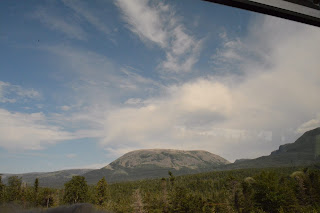 |
| Gros Morne |
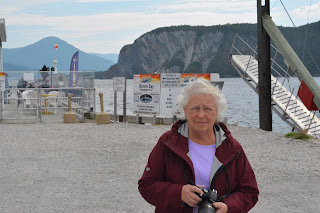 |
| In front of tablelands |
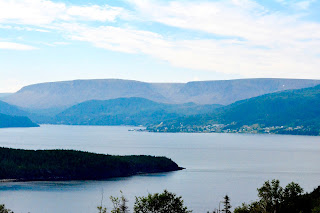 |
| Barren Tablelands in Gros Morne |
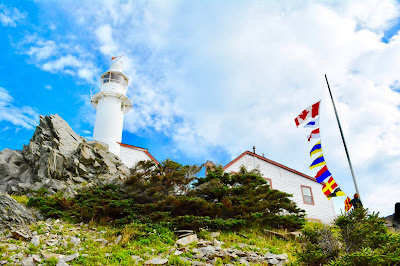 |
| Lobster Head Bay Lighthouse |
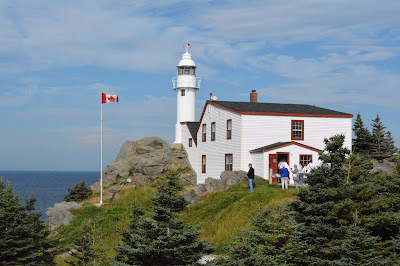 |
| One of four “Imperial” Lighthouses on Belle Isle Strait |
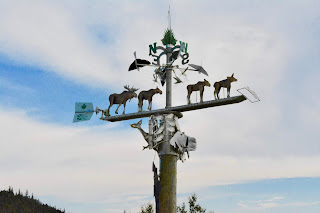 |
| Moose Windvane in Gros Morn park |
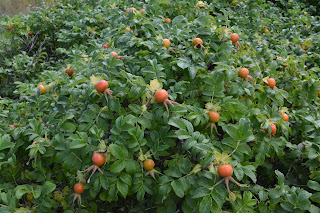 |
| Lots of rosehips in Gros Morn |
The tour took most of the day, and we were the last tour group back on board before our scheduled 1600 departure. The departure was marred by a massive power blackout as we moved away from the dock, with the ship drifting powerless, the lights out, emergency hall lighting on and massive clouds of white smoke coming from the stacks.
The ship was close enough to the dock that they were able to throw heaving lines ashore and slowly winch the ship back to the dock. The problem was resolved, apparently, and the ship finally departed Corner Brook at 1930.
August 28, 2018
Seabourn Quest continued into the Gulf of Saint Lawrence and entered the river about 1900. Quebec City is some 200 miles inland, but the river is still very wide. We spent several hours trial packing our luggage for the trip home on the 30th. We also had the final lectures on “The Route of the Vikings”, this time looking at the Eastward expansion into the Caspian and Black Seas.
August 29, 2018
Arriving at the cruise ship terminal just below the Chateau Frontenac at the foot of the old part of Quebec City at 0730, we joined 17 fellow passengers whose travel agents were part of the Virtuoso Network. After a driving tour of the old city we headed to Ilse d’Orleans, an island just downstream from the city. Originally named Ilse d’Bacchus by Jacques Cartier in 1536, it was renamed by XXX after himself about 1540.
Visiting a Cassis farm and winery we tasted several concoctions of Cassis or Black Current wines and liqueurs. Following a sightseeing tour of the eastern end of the island, we stopped at a restored dwelling dating from the 1500’s that belonged to a surgeon and landowner. The host was in period costume and the house was well done. Lunch was at a small restaurant “Moulin Laurent”, a converted mill, hence the “Moulin” or windmill in the name. During lunch the skies opened up and we boarded our bus in the rain for our final stop of the day, the “Isle de Bacchus” winery where we tasted three varietals and toured the operation.
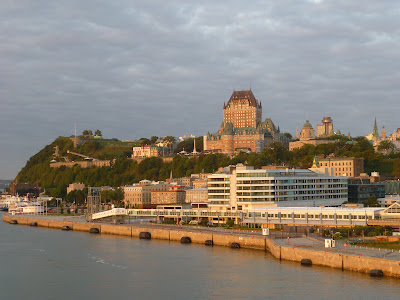 |
| Approaching our dock in Quebec |
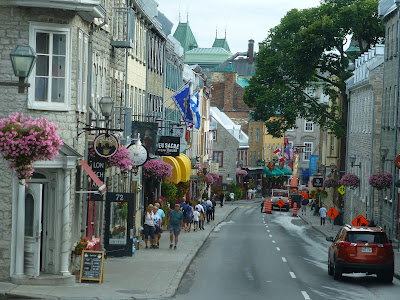 |
| Old City Streets |
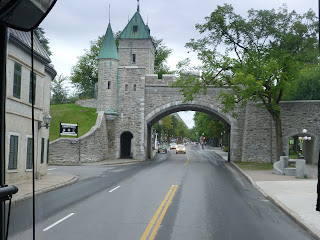 |
| One of Quebec city gates |
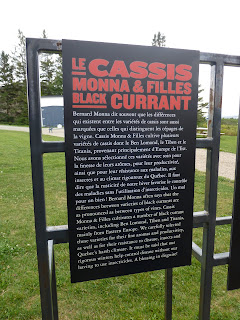 |
| Cassis Farm |
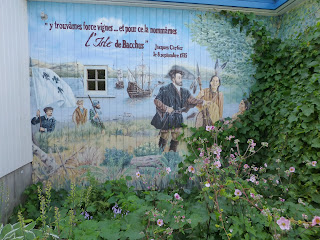 |
| Winery |
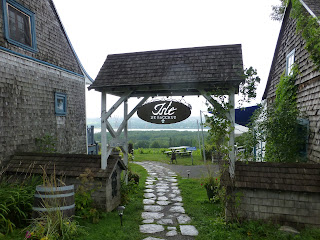 |
| L’Isle de Bacchus Winery |
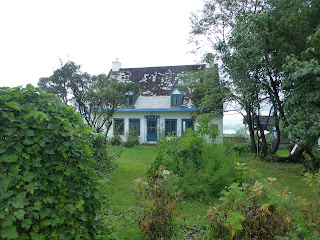 |
| Winery |
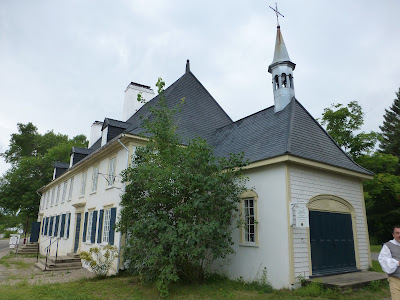 |
| Historic Mansion from 1500’s |
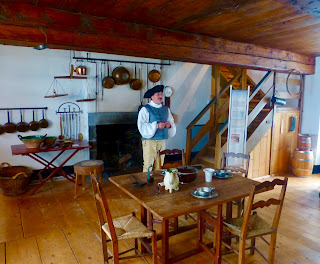 |
| Inside Mansion |
 |
| Moulin Laurent Restaurant |
Heading back to the ship in the rain, we finalized our packing and met with friends in the Observation Bar for last drinks before departure and disembarkation the next morning. The final “sailaway” party for the ship was moved to the Grand Salon because of the rain. After being underway for several hours, the captain made an announcement that there was a main engine cooling issue that required immediate attention and that we would be anchoring in the river until it was rectified. We were worried since we had an early flight and any delay would mean missing the flight on a holiday weekend with no backup flights. After some time, the problem was rectified, no firm explanation given, and the Seabourn Quest raised the anchor and proceeded at full speed towards Montreal, with a one hour delay expected.
August 30, 2018
To our surprise, time was made up and we docked only 30 minutes late and we actually made our transportation 5 minutes early, only to run into traffic jams on the way to the airport. Arriving at 0835, we checked in and found Patrick had been randomly selected for additional screening (searches) which took extra time. However, we still arrived at the gate in time for our flight to Chicago and the connection to Seattle. We had a 7 hour layover at O’Hare, but our passes to the “United Club” provided a place to wait with some food, drink and fewer crowds than in the main terminal.
The United flight to Seattle was uneventful and our trip ended with our arrival home just before midnight.
Route of the Vikings – Post 6
August 20, 2018
As expected, the winds and seas increased overnight as we approached our next wildlife stop, Akpatok Island, which has more than one million Brunnich’s Guillemots nesting and breeding in crevices in the 800 foot high limestone cliffs. The island is also home to walruses and polar bears.
With the seas at 2-3 meters and sustained winds to 35 knots, the captain cancelled the planned zodiac expeditions due to safety considerations in launching, boarding and retrieving the zodiacs. The 38 degree temperatures combined with the winds made for chilly viewing as the captain substituted scenic cruising several miles off the beach for 2 hours. There were purportedly 2 polar bears on the beach, but our enlarged photographs showed only light colored limestone rocks which had fallen from the cliffs. We headed for our next stop, Happy Valley-Goose Bay, two days away. As we cruised back out of Hudson Strait the ship motions and shuddering increased for a while as the winds continued to build.
We were treated to two more impromptu lectures, one on Inuit art and one on killer whales and the impact on the arctic as the whales range further north in search of prey. Finally, near evening we turned the corner back into Davis Strait and paralleled the Labrador Coast.
August 21, 2018
About 0200 we briefly watched the Northern Lights under clear skies. Unfortunately, they were faint and not much color, impossible to photograph from a moving ship.
Dawn brought sunny skies and cool weather, with the coastline in the distance on the right and a steady parade of icebergs as we continued our journey.
There are three lectures today, one on ocean trash, one on Arctic Seabirds and finally, a presentation by Trevor Potts and his amazing recreation of Shackleton’s voyage in 1993 in a similar open boat with no liferafts or other support equipment. The boat is now on permanent display in Cambridge, England.
August 22, 2018
The clear but cool weather we enjoyed yesterday has been replaced by wind, low clouds and rain as we continue to make our way to Happy Valley-Goose Bay. We are out of Davis Strait and in the Labrador Sea. Later in the day the rain was replaced by fog, so once again we hear the foghorn going off every two minutes.
The fog lifted as we approached the entrance into Lake Melville, a large tidal estuary where Happy Valley-Goose Bay is located. The ship picked up a pilot and proceeded into the relatively narrow entrance. As we transited the entrance we were treated to the sight of three Orca splashing alongside the ship.
By dinnertime, the rain returned and continued throughout the night.
August 23, 2018
Happy Valley-Goose Bay
Seabourn Quest continued the 100 nautical mile journey up Lake Melville overnight and docked at the Port of Goose Bay shortly before 0800. Rain was expected to continue most of the day, with mild temperatures. The dock is about 5 miles from the Happy Valley town center and several miles from the airbase at Goose Bay.
We had selected a shore excursion to the town of North West River, which is literally at the end of the road system in Labrador. Until a bridge was built in 1981 the only ways to get to North West River were by boat or a cable car spanning the river.
Until the early 1940’s when the airbase was built, this was an Inuit barter economy town where people hunted and trapped and traded at the Hudson Bay Company store for items they could not gather for themselves. Our first stop was at the Hudson Bay Company Store, now a museum, showing how the store looked and operated in the early 1900’s.
After wandering through the displays we walked for several blocks, some on a re-creation of the old boardwalk, to a little café where the local Inuit ladies had prepared a lunch of soup, sandwiches and desserts, all home cooked. It was a delightful experience as we learned what life was like in the small town of 500 people from the people who actually live there. After lunch we travelled by bus to the Labrador Interpretive Center, going down a road called “Airstrip Road” since it started as an emergency airstrip.
The interpretive center was well done and had lots of information on the different peoples who have lived in Labrador, going back 10,000 years, plus a special focus on the transition in recent years from a barter economy to a wage economy and the restoration of Inuit lands and rights.
North West River is also the location of a Canadian Discovery Channel reality TV show appropriately called “Last Stop Garage” and one of our guides has a brother who is in the show.
Following the tour at the Labrador Interpretive Center we were given a short detour to Happy Valley and the Northern Lights Military Museum, a private collection in the basement of the “Northern Lights” store (formerly a Hudson Bay Company Store) that stocked a little bit of everything from clothing, camping, guns and souvenirs.
Returning to the Seabourn Quest, the sun finally came out and many local inhabitants lined up in their cars to wave us off, sounding their horns while our Captain replied with the ship’s horn.
Route of the Vikings – Post 5
August 18, 2018
Reflections on Greenland while at anchor in Iqaliut
Before taking this trip we had scoured the internet for books on Greenland and settled on “This Cold Heaven” by a Danish author, Greta Erlich.
The book was a well written mix of personal stories and the history of the waves of inhabitants in Greenland, but focused more on the areas north of Ilulissat, which is as far north as we went on this trip.
The two towns north of the Arctic Circle we visited were much like the descriptions in the book. However, Greenland is moving so quickly into the modern world that much of the Inuit traditional life seemed to us to be swallowed up by cars, modern buildings, stores, café’s, airports, and modern small boats. The movement of people from the small settlements into the larger towns and the construction of more and more apartment blocks has been swift. Several of the towns had massive fish processing plants to handle the fish caught from the productive waters fed by the Labrador Current.
Greenland has also been “discovered” by tourists like us, with more cruise ship visits and the allure of adventure travel to one of the last isolated places on earth. So, some of the towns cater to skiers, hikers, fishermen and other outdoor enthusiasts. Just in Ilulissat alone we saw four other cruise ships, some just scenic cruising, others like the Seabourn Quest anchoring off the town and going ashore or cruising the Icefjord in Zodiacs. There was a thriving business of locally operated whale watching and iceberg tours.
I think what surprised us the most was the amount of “green”, the variety of vegetation thriving in the brief summer season. We also did not realize how much of the western coastline is ice free all year, even north of the Arctic Circle.
Last night we anchored off the town of Iqaluit, the capital city of Nunavut. Before the Northwest Territories were split in two, the town was called Frobisher Bay and sits on the bay itself. We are not allowed off the boat and into the town, it is Canada Customs clearance only. There are still patches of snow on the surrounding hills, which are much lower and rounded compared to Greenland’s west coast.
The morning was overcast, but by noon patches of sun broke through the clouds as we prepared to head for our next stops, zodiac tours by three islands, Monumental Island, Lady Franklin Island and Akpatok Island, where we may see polar bears and other wildlife. This will be possible only if the wind and seas permit launching the zodiacs.
Sunday, August 19, 2018
Lady Franklin and Monumental Islands
The ship is lying still several miles off the islands, which are in Davis Strait and in the open ocean. There are icebergs of various sizes visible all around the horizon. The winds are light as promised, with a low swell. At 0530 we headed to the embarkation point for the zodiac tour at 0600 to Lady Franklin Islands. The first departure group was small, only 21 people and 2 zodiacs. Heading to the islands, the fog began to settle in as the sun rose higher above the horizon through broken clouds. Our guides spotted a polar bear on one of the islets comprising the group and we were able to approach quietly and get some photos and observe through binoculars. The were also Ravens, Black Guillemots and Fulmars on the island or in the water.
Route of the Vikings Post 4
Route of the Vikings – Part 4
August 7, 2018
After holding station in the wind and waves for several hours, we listened to the local pilot describe his experiences during the eruption in 1973. He was 11 years old at the time and talked about the noise, earthquakes, sirens waking people and the ash. Fortunately, the fishing fleet was in and all 5000 residents were evacuated to the mainland, where many remained for more than two years. There are now about 4000 residents in the town, with regular ferry service to the mainland.
Turning around in the 40 knot winds, we headed back down the east side of the Westman Islands, past the final Island of Surtsey, the newest volcanic island in the chain.
Heading just slightly south of west, our ship then headed out into the Denmark Strait for the 850 nautical mile crossing to the south of Greenland and Prince Christian Sound where we will do scenic cruising. The ship continued moderate rolling in the seas and winds, which gradually calmed overnight.
August 8, 2018
Today is a quiet day at sea, with a mandatory briefing required for passengers on all ships belonging to AECO (Arctic Expedition Cruise Organization), similar to the briefings required before we landed in Antarctica several years ago. The briefings cover protection of the environment, wildlife, plants and indigenous cultures we will be exposed to while ashore. No passenger will be allowed ashore if they did not attend the briefing.
We then attended a lecture with photos on all the Greenland ports we will visit, with information on what we will see and do, very informative.
The Captain’s Reception was held this evening, it was a low key event, just the introduction of part of the senior crew and two short performances by members of the shipboard entertainment staff. Later in the evening, the fog horn started sounding as the visibility decreased. Dinner this evening was in “The Grill”, the Thomas Keller specialty dining venue emulating a 50’s-60’s Steakhouse with a modern flair. In our opinion the food we chose was good, but not great and the portions were too large for us.
The foghorn continued all night.
August 9, 2018
This morning we are approaching the southern tip of Greenland, in dense fog. Our destination for the day is Prince Christian Sound, which separates the mainland from the southern island and Cape Farewell via a narrow channel not unlike the fjords in SE Alaska, Norway and British Columbia. We will enter from the east and exit on the west coast some 100 kilometers later.
The fog lifted about 3 miles from the coast and we entered the narrow passage in rain. The ship stopped about 5 miles up the passage and offloaded 4 zodiacs for our tour. We were in the first wave, 40 people/10 per zodiac. In cold rain, heavy at times, we explored ahead of the ship and into the first tidewater glacier coming down from the Greenland Ice Cap. There were a number of bearded seals lounging on the ice floes and the glacier was actively calving. By this time, the ship caught up with us and waited outside the inlet while we pushed as far into the ice as possible, getting to within about ¼ mile from the end, the closest safe distance if a large calving were to occur.
Returning to the ship, after disembarking and having some hot chocolate, Patrick headed out on the second zodiac tour. The rain was much lighter and when close to the glacier face, a large segment splashed down creating a miniature tsunami. The waves were about three feet high when they reached the zodiacs.
After returning to the ship the zodiacs were loaded back into the stern compartment and the Seabourn Quest continued its transit of Prince Christian Sound, zig zagging our way to the west coast of Greenland past more glaciers and spectacular jagged peaks and one small town of 130 people. We exited back into the open sea and more fog banks about 1800.
August 10, 2018
Qaqortoq, Greenland
Our stop for today was Qaqortoq, the largest city in South Greenland, with a population of more than 3200. The Seabourn Quest anchored in the fog about 0630, just off the small harbor, which was often not visible.
Shortly after, the cruise ship Nautica also anchored. At 0900 we departed on our Zodiac tour, in the fog, for a one hour ride to the Norse Greenland Unesco site at Hvalsey, consisting of a church and other buildings, partly excavated, dating to the 10th century. The site was abandoned sometime before 1500, the exact date is not known. The fog lifted for most of our one hour visit and then settled back in as we headed back to the ship, past several large bergs.
Due to fog, Patrick’s kayaking tour was cancelled, so after a quick lunch during which the fog disappeared and the sun appeared, we both headed ashore and took in some local sights, including a fish market with freshly caught whale meat and shops selling very expensive souvenirs.
August 11, 2018
Paamiut, Greenland
Most of the evening the ship sailed in clear seas, but in the morning the fog settled in close to the coast as we approached our anchorage off the small town of Paamiut. The fog lifted just before the decision to cancel the water tours, so we were able to go. Miriam did a Zodiac Tour and Patrick did sea kayaking. Both tours passed by shipwrecks, icebergs, whale carcasses and fishing equipment. After lunch we headed ashore and walked the town, went through the museum and hiked up to a viewpoint. Although small, this town had a lot of charm, with a restored turf house and old fishing vessels on display.
Returning to the ship we were treated to views of a number of humpback whales as we exited the anchorage. The weather was nice enough to eat outside at the Patio Grill, although we did have blankets for added warmth. During dinner we passed a section of the Greenland Ice Cap looking like a massive fog bank lying on top of the land.
August 12, 2018
Nuuk, Greenland
Nuuk is the capital of Greenland and its 17,000 inhabitants comprise about 30% of the total Greenland population. One of the apartment blocks houses more than 1% of people! The town is situated on a rocky hill projecting out at the intersection of two fjords.
Seabourn Quest docked at the port, the first time we have been dockside since leaving Reykjavik. Patrick took a zodiac tour up Kobbefjord to a lake and research station. The relatively warm weather brought out millions of mosquitoes and took the edge off an otherwise great excursion. After Patrick returned to the ship Miriam and Patrick headed into town for a guided tour of the Greenland National Museum, led by Dr. Colleen Batey, who is an expert on vikings. The visit included the “Norse” Greenlanders and the Greenland mummies dating to 1475 which were found a few years ago.
August 13, 2018
Maniitsoq, Greenland
Arriving in dense fog off the town of Maniitsoq, all operations were delayed until the fog lifted enough to see the shore. The ship was about 2.5 miles from town due to reefs too dangerous to anchor near. The morning kayak trip was cancelled, so when tender operations were started, 90 minutes late, we headed into town, visiting the fish market, museum, hotel, jewelry workshop, church and graveyard. It was also the first day of school for the local kids, so that was interesting. Both the children and parents were dressed in traditional costumes for the event. Patrick did another kayak tour in the afternoon. These are really small towns, reminiscent of towns like Wrangell in SE Alaska (minus the seal and porpoise meat and musk ox in the local meat market).
August 14, 2018
Sisimuit, Greenland
The second largest city in Greenland, with 5600 inhabitants, had a dock long enough for the Seabourn Quest to dock, rather than anchor and tender in to shore. The town is built on a rocky headland below a mountain, with steep roads, colorful houses and ancient archeological sites dating to 4500 BC and the Saqqac people believed to be among the first human inhabitants in Greenland.
We are now above the Arctic Circle and the Greenland Sled Dogs are now everywhere. They are either chained up in town or loose on many of the small islands around the town. Passing by the islands on the kayaks was amazing as the dogs followed us, howling all the time.
We have still not seen much marine wildlife, perhaps more in Canada.
August 15, 2018
Ilulissat, Greenland
This town, now the third largest in Greenland, lies at the mouth of Ilulissat Icefjord, a UNESCO world heritage site. This single glacier drains between 7 and 10 percent of the entire Greenland Ice Cap and is believed to have spawned the iceberg that sank the Titanic more than 100 years ago. We approached the town and icebergs starting about 0300, with many guests watching from the observation lounge.
At 0800, after anchoring in the middle of several large bergs, we headed out on Zodiacs, weaving among the big bergs and stopping to watch Humpback Whales feed. After 2 hours, we headed back to the ship and changed out of zodiac gear and took the tender into the town. Ilulissat is growing rapidly, with much construction, but still has thousands of sled dogs chained around town, howling as one walked by. The town has an airport and many outdoor activities possible, from fishing, winter sports to visits to lodges at the terminal edge of the glacier some 40 kilometers away.
Patrick walked the several miles each way trek to Sermermiut, both the site of settlements from 4500 BC, and of spectacular views of the Ilulissat Icefjord.
After a “Caviar on the Ice” sail-away party on the pool deck, the captain wove his way through the icebergs passing very close to some spectacularly shaped bergs and back into the relatively open sea for our crossing of Davis Strait and on to Canada for the rest of our voyage.
August 16, 2018
Transiting Davis Strait
This day at sea gives us time to sort through our photos, attend some lectures on our upcoming destinations, both the cultures of the Inuit and the wildlife we are looking for. There are still bergs visible, some large but most relatively small. The visibility was poor, with the ship’s foghorn sounding much of the day and into the evening. This was the second formal evening, with a set “Chef’s Menu” in the main dining room.
August 17, 2018
Transiting Davis Strait
The weather deteriorated overnight and we woke to 30 knot winds and rain from the south. We will arrive at the town of Iqualuit for customs clearance into Canada about 2200 this evening. No one is allowed off the ship. We are arriving early due to the need to hit slack water at the entrance channel, which has currents of 6-7 knots.
Route of the Vikings Part 3
Vikings Post 3
August 7, 2018 – standing off Heimaey, Iceland
The wind is whistling through the door to the veranda. With winds steady at 38-40 knots and seas 2-3 meters, the Captain has wisely decided to cancel the port visit. There is no safe way to launch the tenders, much less transfer guests ashore through the seas into the inner harbor. As the morning wore on, a mist from the water and wind began to obscure the detail and the horizon disappeared.
A few photos will have to suffice, along with a lecture later this morning by a resident who was here when the volcano erupted and buried the town. The town is now a UNESCO World Heritage Site, called the Pompeii of the North.
 |
| Add caption |
Route of the Vikings – Part 2
Route of the Vikings Part 2
August 5, 2018
After another noisy holiday weekend night in the hotel room we had an early breakfast and headed out at 0800 on our second Super Jeep tour, which included a visit to the ice cave on the Langjokull glacier. On the way to the ice cave we visited a number of scenic areas with old whaling stations, and the fjord where the Murmansk convoys were formed during WW2.
Two of the more interesting stops were a thermal spring providing hot water for several towns up to 75 KM away, with the hot water bubbling up at the rate of 180 liters/sec and the site of “Snorri’s” home and pool dating back to the 1200’s. Snorri was a both an influential person in the Icelandic Parliament at that time, but was also a historian who recorded the oral stories of the Icelandic people and a poet. He was killed by the King of Norway after refusing to hand over control of Iceland to the Norwegians in 1241. All that is now left are some foundations and the pool.
After lunch near the ice cave staging area we headed out on a gravel road through the lava fields and then on to the terminal moraine of the glacier. Lowering the air pressure on the Super Jeep tires we headed up the glacier. The surface was mushy from the sunshine and warm temperatures and we thought we might get stuck. Our driver finally got out and lowered the air pressure even further and we proceeded up the glacier on a marked safe route which avoided the crevasses. Arriving at the entrance we waited for the guides to arrive on the converted missile launcher filled with people on group tours. We were in the first group into the darkened tunnel, going about 100 meters inside to a staging area where we put crampons on our waterproof overshoes before heading even deeper into the ice. Light was provided by LED’s buried in the ice walls, giving a blue glow. The cave then branched into a loop about 500 meters in length, with a number of rooms, a chapel, crevasses, pools and a constant rain of water making it’s way through the ice. At the deepest part we were 45 meters below the surface.
Exiting the tunnel we headed back down off the glacier and took a different route through lava fields back to Reykjavik, passing a number of volcano craters and geothermal plants.
Our guide recommended a restaurant, the 3 Frenchmen, which served traditional Icelandic dishes. We tried smoked Puffin Breast as one of the starters, with halibut as the main course, followed by a Skyr Crème Brulee.
August 6 – Embarkation Day
Arising early for a 0715 departure for a tour to the Puffin Island in the harbor, we met our driver and found the tour was only about 4 blocks and 10 minutes walking from the hotel. It was sunny, but also windy so the round bottom wood boat boat rolled heavily on the way to the island. Nonetheless, we did see puffins and got a few pictures before returning to the hotel.
Route of the Vikings – Iceland to Newfoundland and Beyond
Route of the Vikings – Iceland to Newfoundland and beyond
August 2, 2018
Today Miriam and I boarded an Iceland Air flight to Reykjavik to begin a nearly one month journey from Iceland to Greenland, across Davis Strait to Baffin Island. Following the eastern coast of Baffin Island, we then cross to Labrador, Newfoundland and Nova Scotia, through the St. Lawrence waterway to Quebec and finally ending up in Montreal.
Most of our trip will be on board the Seabourn Quest, the same ship we travelled on to Antarctica and Northern Norway over the past several years.
We begin our trip with three days of private tours in Iceland before boarding the ship.
The flight did not depart on time from SeaTac. The scheduled departure was 3:05 PM, the actual was closer to 4:00 PM. The flight time was predicted to be slightly shorter, so the net delay should have been probably 30 minutes.
Once on board and settled into our seats, we were presented with a gin bar menu, with a number of interesting gins, including ones with cucumber, elderflower and other botanicals. The meal was fine, the service good, but the limited recline and close pitch on the seats made sleeping difficult for both of us.
August 3, 2018
We were unable to make up the departure delay, in fact it was an even later arrival than anticipated, with low clouds and rain, heavy at times as we landed at the sprawling Keflavik International Airport, also the site of a major USAF base until 2007. After transferring by bus to the main terminal, we had a long walk to immigration and an even longer walk to baggage claim . The line was very long for immigration, so instead of being outside the terminal searching for our driver before 0600, it was 0730.
Also, there was no driver waiting, as scheduled. Activating our cellphone with the AT&T international day pass, we called the Seabourn emergency number in Iceland and also talked to another Seabourn driver who was holding a sign for a similar name, who also called someone on our behalf. Soon that driver approached and said he had been contacted by Seabourn and off we went, after we also received a call back from Seabourn with the same info. The 45 minute trip into downtown Reykjavik to the Radisson Blu 1919 Hotel was in rain, heavy at times, so the views of the countryside were mostly obscured.
Our day long private Super Jeep Golden Circle tour was scheduled to depart too soon after arriving at the hotel, but a simple phone call also fixed that issue. As expected, the room was not yet ready, but the hotel stored our luggage and we enjoyed a quick buffet breakfast, with a good selection of both hot and cold items. Our tour guide, Tryggve, was easy to find in the lobby and our vehicle was waiting right outside the hotel. With 46 inch diameter tires, Miriam used a small step ladder to enter and exit the vehicle. We left only 30 minutes later than the original schedule.
Our route out of Reykjavik took us north by the harbor and past the building where Reagan and Gorbachev ended the cold war, meeting on neutral ground halfway between Washington, DC and Moscow. The rain and low clouds obscured the views for a while as we headed for our first stop, Pingvellir National Park, the crack in the earth marking the junction between the North American and European tectonic plates. A small footbridge across the gap allowed us to walk from one continent to another in just a few steps! On the plain below the crack was the site of the original Icelandic parliament, dating back more than 1000 years to 930 AD. The site still contains the summer residence of the President of Iceland. Walking down the hill from the North America plate through the crack, past the ancient Parliament site, we met our driver at the other end of the trail on the European tectonic plate and continued on northeast into the countryside.
Our next stop was scheduled to be the “Geysir” fields, similar to Yellowstone. Our guide diverted to a working farm for freshly made ice cream, delicious, and with views of the milk cows, which have been trained to use a automatic milking machine, electronically tracking the milking frequency and quantity from each cow. The cows often enter the machine 8-10 times a day, in search of the special feed they know awaits them.
Arriving at the “Geysir” fields, we walked by two, “ Strokkur and Geysir”, which erupt with regular frequency and were fortunate to see both erupt multiple times. We then enjoyed a delicious buffet lunch in the brand new Geysir Hotel, which incorporates part of the original hotel façade into the lobby.
The rain stopped for a while and we changed the route to go off the paved roads onto the rough tracks leading to the eastern side of the Langjokull Glacier, the second largest in Iceland, more than 100 kilometers in length. Deflating the tires of the Super Jeep to better negotiate the rocky terrain left as the glacier receded, we then drove up onto the glacier, following a path which had turned into a stream from the meltwater. The glacier was dotted by piles of volcanic ash and looking into the blue ice, one could see the layers of black ash, just like tree rings, dating the many volcanic eruptions which have taken place. The surreal landscape, with both black and green mosses and lichens as the first vegetation reclaiming the land, provided some of the inspiration for Tolkien’s “Lord of the Rings” trilogy, as well as Jules Verne’s “Journey to the Center of the Earth”
Retracing our path out of the glacial terrain, we headed southeast, stopping at the spectacular Gullfoss Falls, which translates as “Gold Falls”. We were able to walk down a path and out onto a promontory jutting out into the middle of the falls, with the thunderous water rushing by from above and disappearing into the gorge below.
Jetlag and lack of sleep started to catch up, as well as the day ending, so we returned southwest via another route to Reykjavik, passing a major geothermal electrical generating site. All along the route, many steam vents dotted the landscape.
We arrived at the Radisson Blu 1919 Hotel just before 1800 and were able to finally check into our room on the 4th floor. Not even waiting to unpack or open our bags, we headed out into the old town surrounding the hotel and dined on a superb 4 course sampling meal of Icelandic food at the “Fiskefelagid” or Fish Company restaurant, located in the lower floor of a historic building in the old town, just two blocks from our hotel.
The approaching weekend is a three day “bank holiday” and a music venue was set up in the street just down from the hotel, complete with grass sod placed on the street for a temporary lawn. For us, suffering from jetlag and lack of sleep, the music and voices from the street below made sound sleep difficult, since the party was still going strong at 0500 the next morning.
August 4, 2018
The day began with a buffet breakfast in the hotel and then we met our tour guide for the morning. After visiting the spectacular Lutheran Church with the 73 meter spire, we drove through a number of small communities and fishing villages on our way to the Rekjanes Peninsula. The main attractions were lava fields, geysers, scenic volcanic shorelines and another version of the “crack in the earth”. Some of the areas were Unesco world heritage sites. In the afternoon we had a three hour stop at the “Blue Lagoon”, which is hard to describe in words. The facility is well run, modern and the water is a milky blue from the silica and other chemicals. The temperature is even, ranging from 37-39 degrees Celsius as one moves around the lagoon. There were hundreds of people, but it still did not seem particularly crowded. The sunny skies were a welcome change. We tried the facial masks, both silica and algae, had a drink at the walk up bar, took videos and generally relaxed. After 90 minutes in the water, we showered and had a quick lunch at “Lava”, with complimentary sparkling wine and then back to the hotel.
Right outside the hotel is the hotdog stand that Bill Clinton made famous, but after standing in line and having one, we don’t know what all the hype is about. The hotdog casings were tough, as were the buns. A short walk in the sunshine to the main square, filled with restaurants and people was enjoyable.
2018 Alaska Ends
July 16, 2018
This morning Spirit returned to her homeport in Anacortes after 2546 nautical miles.
 |
| Spirit and Steel Tiger in Khutze Inlet |
The trip south from Petersburg was speedy, but the rain persisted until we departed Ketchikan. Stopping for the night in Foggy Bay, we anchored with four sailboats, all headed north. The next morning, on the 30th of June we departed under clear skies across Dixon Entrance and were moored at the new municipal docks at Prince Rupert by 1400.
We had a great dinner at the Cow Bay Cafe and reprovisioned for the dash south to Port McNeill to meet Patrick’s sister on July 7. Our route took us to Lowe Inlet, Rescue Bay, Pruth Bay, Alison Harbor for July 4th with the Johnson’s on Steel Tiger and then a relatively short run to Port McNeill. Cape Caution was obscured by dense fog, but calm seas.
From Port McNeill we headed to Pierre’s at Echo Bay for the Saturday Pig Roast and Pierre’s 65th birthday. After at stop at Port Harvey with it’s new buildings and good pizza we headed to Shoal Bay. We spent two nights at Dent Island Lodge and were pleased at how nice the new main lodge turned out.
Departing Dent Island Lodge the morning of July 12, we headed to Rebecca Spit, but the northwest winds made the anchorage uncomfortable with 2-3 foot seas, so we pulled the anchor and headed to Tribune Bay on Hornby Island. The anchorage was still windy, but with little fetch there were few waves.
The weather cooperated with NW winds as we continued south, hitting slack tide at Dodd Narrows and anchoring in Montague Harbor before 1600. After an evening in the sun, we moved to Port Browning in the morning to try and escape the brisk NW winds, to no avail.
On the morning of July 15, we crossed the US boundary in Haro Strait and later anchored in Echo Bay on Sucia Island. The brisk NW winds continued.
Under sunny skies we made the short 22 nautical mile trip to our homeport in Anacortes Marina, arriving shortly before noon.
Alaska 2018 Blog Post 11
It has been one month since we have posted, for a reason. We all the emphasis on individual privacy, we have chosen not to post pictures of our friends and family. The locations we have cruised have all been documented in previous years, so…








